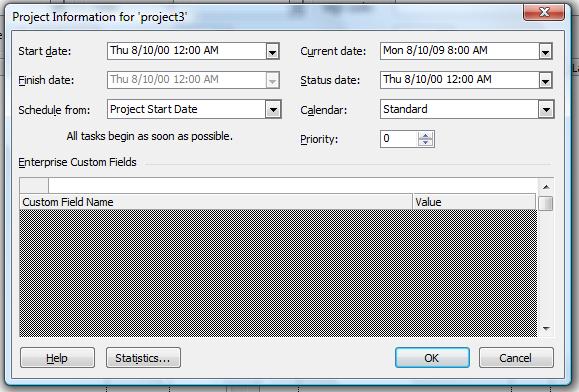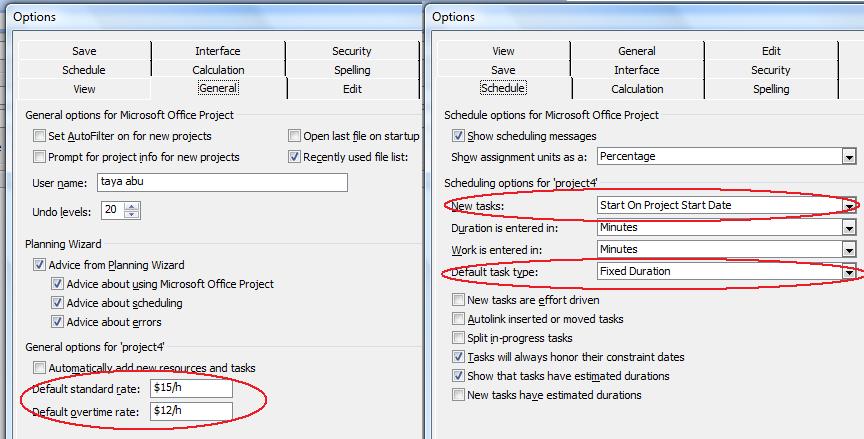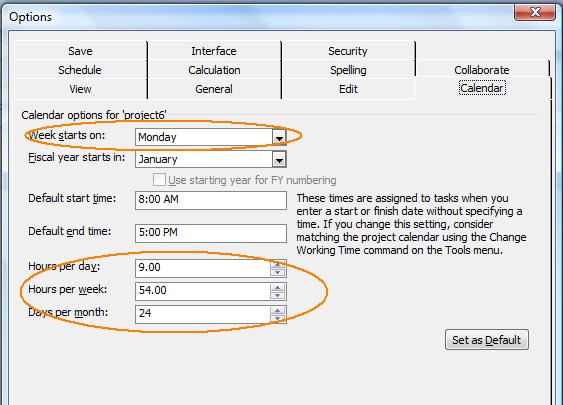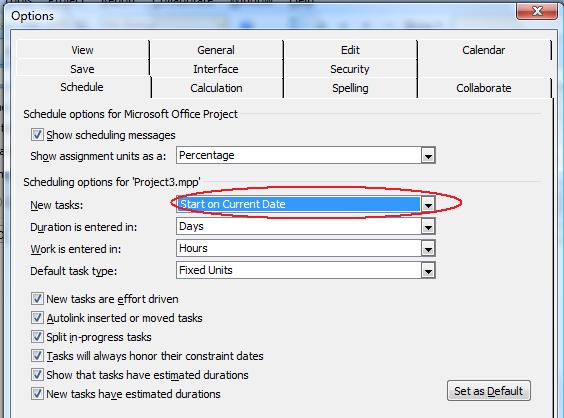Working with Project Properties
Working with General Project Properties
Microsoft Project saves project properties, metadata, for every project. The properties include the project’s start and end dates, the current date and the status date, the type of calendar used and when a project is scheduled from. Aspose.Tasks for Java lets you read and set project properties. This topic shows how.
Please note that you cannot set values against the Application and Producer fields, because Aspose Ltd. and Aspose.Tasks for Java x.x.x will be displayed against these fields
Reading Project Information
The Prj class has a number of properties that deal with project properties:
- START_DATE: the project’s start date, of the Date data type.
- FINISH_DATE: the project’s end date, of the Date data type.
- CURRENT_DATE: the current date, of the Date data type.
- STATUS_DATE: the date that the project’s progress will be reported, of the Date data type.
- SCHEDULE_FROM_START: defines whether the project is scheduled from the start or end data and takes a Boolean value.
- CALENDAR: the type of calendar used by the project, managed through the Calendar class.
To read project properties in Microsoft Project, click Project Information on the Project menu.
Reading project properties in Microsoft Project

The programming samples below show how to read and output the project start and end date, whether the project is scheduled from the start or end, the current date, status date, and the calendar type.
1Project project = new Project(dataDir+ "input.xml");
2 if(project.get(Prj.SCHEDULE_FROM_START).getValue())
3 System.out.println("Project Start Date : " + project.get(Prj.START_DATE));
4 else
5 System.out.println("Project Finish Date : " + project.get(Prj.FINISH_DATE));
6 String strSchdl = (project.get(Prj.SCHEDULE_FROM_START).getValue())?"Project Start Date":"Project Finish Date";
7
8 System.out.println("Project Schedule From : " + strSchdl);
9 System.out.println("Current Date : " + project.get(Prj.CURRENT_DATE));
10 System.out.println("Status Date : " + project.get(Prj.STATUS_DATE));
11 System.out.println("Calendar : " + project.get(Prj.CALENDAR).getName());Writing Project Information
Aspose.Tasks for Java can write as well as read project information. The code samples below show how to set the scheduling start point, the start date, current date, status date, and calendar type.
1//Create a project instance
2Project project = new Project();
3//Set project information properties
4project.set(Prj.SCHEDULE_FROM_START, new NullableBool(true));
5java.util.Calendar cal = java.util.Calendar.getInstance();
6cal.set(2014, 7, 10);
7project.set(Prj.START_DATE,cal.getTime());
8project.set(Prj.CURRENT_DATE, cal.getTime());
9project.set(Prj.STATUS_DATE, cal.getTime());
10
11//Save the Project as XML
12project.save(dataDir + "project3.xml", SaveFileFormat.XML);Determining Project Version
Aspose.Tasks for Java lets you retrieve project file information such as the version of Microsoft Project that the file was created with. The Project class exposes the get() method for getting this information using the static Project class.
The SAVE_VERSION and LAST_SAVED properties exposed by the Project class is used to determine the project version and the date when the project was last saved.
1// For complete examples and data files, please go to https://github.com/aspose-tasks/Aspose.Tasks-for-Java
2// The path to the documents directory.
3String dataDir = Utils.getDataDir(DetermineProjectVersion.class);
4Project project = new Project(dataDir + "input.xml");
5// Display project version property
6System.out.println("Project Version : " + project.get(Prj.SAVE_VERSION));
7System.out.println("Last Saved : " + project.get(Prj.LAST_SAVED));
8
9// Display result of conversion.
10System.out.println("Process completed Successfully");Default Project Properties
Microsoft Project lets users set default project properties that speed up the process of setting up a project. The default properties define when a new task starts and finishes, sets the default overtime and standard pay rates and more. Aspose.Tasks for Java supports these features. This article explains both how to read default properties and how to write default properties to a project file.
The Prj class exposes a number of properties for managing a project’s default properties:
- DEFAULT_START_TIME: a new tasks’ default start time, takes a Date value.
- DEFAULT_FINISH_TIME: a new tasks’ default finishing time, takes a Date value.
- DEFAULT_FIXED_COST_ACCRUAL: an assignment’s default fixed cost accrual, takes one of the values defined by the CostAccrualType enumeration.
- DEFAULT_STANDARD_RATE: the default standard pay rate, takes a double.
- DEFAULT_OVERTIME_RATE: the default overtime pay rate, takes a double.
- DEFAULT_TASK_EV_METHOD: the default task earned value method, takes one of the values defined by the EarnedValueMethodType enumeration.
- DEFAULT_TASK_TYPE: the project’s default task type, takes one of the values defined by the TaskType enumeration.
To see the default project information in Microsoft Project:
- Open a project.
- On the Tools menu, click Options.
- Go to the General tab. Here, you can see the settings for the default standard and overtime rates.
- Go to the Schedule tab. Here, you can see the settings for the default task type and default task start time.
Default project information in Microsoft Project, as written by Aspose.Tasks

Reading Default Properties
The following example reads a project’s default properties and writes them to a console window.
1// For complete examples and data files, please go to https://github.com/aspose-tasks/Aspose.Tasks-for-Java
2
3 // The path to the documents directory.
4 String dataDir = Utils.getDataDir(DefaultProjectProperties.class);
5
6 Project project = new Project(dataDir + "project.mpp");
7
8 // Display default properties
9 System.out.println("Project Version : " + project.get(Prj.SAVE_VERSION));
10 System.out.println("New Task Default Start: " + project.get(Prj.DEFAULT_START_TIME));
11 System.out.println("New Task Default Type: " + project.get(Prj.DEFAULT_TASK_TYPE));
12 System.out.println("Resource Default Standard Rate: " + project.get(Prj.DEFAULT_STANDARD_RATE));
13 System.out.println("Resource Default Overtime Rate: " + project.get(Prj.DEFAULT_OVERTIME_RATE));
14 System.out.println("Default Task EV Method: " + project.get(Prj.DEFAULT_TASK_EV_METHOD));
15 System.out.println("Default Cost Accrual: " + project.get(Prj.DEFAULT_FIXED_COST_ACCRUAL));Writing Default Properties
The following lines of code set a project’s default properties.
1// For complete examples and data files, please go to https://github.com/aspose-tasks/Aspose.Tasks-for-Java
2// Set default properties
3project.set(Prj.SCHEDULE_FROM_START, new NullableBool(true));
4
5java.util.Calendar cal = java.util.Calendar.getInstance();
6cal.set(2014, 2, 15, 0, 0, 0);
7
8project.set(Prj.START_DATE, cal.getTime());
9project.set(Prj.DEFAULT_START_TIME, project.get(Prj.START_DATE));
10project.set(Prj.DEFAULT_TASK_TYPE, TaskType.FixedDuration);
11project.set(Prj.DEFAULT_STANDARD_RATE, 15d);
12project.set(Prj.DEFAULT_OVERTIME_RATE, 12d);
13project.set(Prj.DEFAULT_TASK_EV_METHOD, EarnedValueMethodType.PercentComplete);
14project.set(Prj.DEFAULT_FIXED_COST_ACCRUAL, CostAccrualType.Prorated);
15
16// Save the project to XML format
17project.save(dataDir + "Project4.xml", SaveFileFormat.XML);
18
19// Display result of conversion.
20System.out.println("Process completed Successfully");Writing Project Summary Information
Most programs save summary information with the files they save. Microsoft Project is no different. As well as the name of the author, the date the project was created and the last time it was edited and saved, it saves keywords, subject, comments and more. Aspose.Tasks for Java lets you both read and write this type of information. This topic explains how to open a project file, set the summary information and save it again.
The Prj class exposes a number of properties to set or get summary information about an MPP project file. Aspose.Tasks for Java can update the project summary information and then write the project file back to MPP. To update the project summary information of an existing MPP file:
- Create an instance of the Project class to read the input MPP file
- Set the various properties exposed by the Project object to define summary information.
- Save the Project using the Save method of Project class
To see the a file’s summary information:
- Find the file in a file browser.
- Right-click the file and select Properties.
- Go to the Details tab.
1// For complete examples and data files, please go to https://github.com/aspose-tasks/Aspose.Tasks-for-Java
2// The path to the documents directory.
3String dataDir = Utils.getDataDir(WriteMPPProjectSummary.class);
4
5Project project = new Project(dataDir + "project.mpp");
6
7// Set some summary information about the project
8project.set(Prj.AUTHOR, "Author");
9project.set(Prj.LAST_AUTHOR, "Last Author");
10project.set(Prj.REVISION, 15);
11project.set(Prj.KEYWORDS, "MSP Aspose");
12project.set(Prj.COMMENTS, "Comments");
13
14java.util.Calendar cal = java.util.Calendar.getInstance();
15cal.set(2014, 2, 15, 0, 0, 0);
16project.set(Prj.CREATION_DATE, cal.getTime());
17project.set(Prj.KEYWORDS, "MPP Aspose");
18cal.set(2014, 3, 16, 0, 0, 0);
19project.set(Prj.LAST_PRINTED, cal.getTime());
20
21project.save(dataDir + "MPPAspose.xml", SaveFileFormat.XML);
22
23// Display result of conversion.
24System.out.println("Process completed Successfully");
25
26// Reading Project Summary Information
27project = new Project(dataDir + "MPPAspose.xml");
28
29System.out.println("Author: " + project.get(Prj.AUTHOR));
30System.out.println(project.get(Prj.LAST_AUTHOR));
31System.out.println(project.get(Prj.REVISION));
32System.out.println(project.get(Prj.KEYWORDS));
33System.out.println(project.get(Prj.COMMENTS));
34
35System.out.println(project.get(Prj.CREATION_DATE).toString());
36System.out.println(project.get(Prj.KEYWORDS));
37System.out.println(project.get(Prj.LAST_PRINTED).toString());Fiscal Year Properties
The fiscal year is the same as a financial year or budget year. It is the dates between which a country, an organization or an individual calculates budgets and taxes. Microsoft Project lets users define a fiscal year for projects. Aspose.Tasks for Java supports this functionality with properties that allow developers to both read fiscal year properties from existing projects, and set fiscal year properties when creating or working with projects.
The Prj class exposes the FY_START_DATE and FISCAL_YEAR_START properties to manage fiscal year for a project:
- FY_START_DATE: define the fiscal year start month and supports one of the values defined by the Month enumeration.
- FISCAL_YEAR_START: determines whether the fiscal year numbering has been used in the project. nullable boolean
Reading Fiscal Year Properties
The FY_START_DATE and FISCAL_YEAR_START properties make it easy to find out what the current fiscal year start date is, and whether fiscal year numbering is used, with Aspose.Tasks.
The following code reads a project’s fiscal year properties and displays them in a console window.
1// For complete examples and data files, please go to https://github.com/aspose-tasks/Aspose.Tasks-for-Java
2// The path to the documents directory.
3String dataDir = Utils.getDataDir(FiscalYearProperties.class);
4;
5
6Project project = new Project(dataDir + "project.mpp");
7
8// Display fiscal year properties
9// Display fiscal year properties
10System.out.println("Fiscal Year Start Date : " + project.get(Prj.FY_START_DATE));
11System.out.println("Fiscal Year Numbering : " + project.get(Prj.FISCAL_YEAR_START));
12
13// ------ Setting Project Fiscal Year Properties
14// Create a project instance
15Project prj = new Project();
16
17// Set fiscal year properties
18prj.set(Prj.FY_START_DATE, Month.July);
19prj.set(Prj.FISCAL_YEAR_START, new NullableBool(true));
20
21// Save the project as XML project file
22prj.save(dataDir + "savedProject.xml", SaveFileFormat.XML);
23
24// Display result of conversion.
25System.out.println("Process completed Successfully");Weekday Properties
Microsoft Project lets users set a number of different weekday properties, for example, what day a week starts on and how many working days are in a month. Aspose.Tasks support these features through a number of properties that can be used both to read weekday properties and to write them to a project.
Aspose.Tasks has a series of properties, exposed by the Prj class, specifically for managing a project’s weekday properties:
- WEEK_START_DAY: the first day of the week. This property takes values defined by the DayType enumeration.
- DAYS_PER_MONTH: the number of working days in a month, passed as an integer.
- MINUTES_PER_DAY: the number of working minutes in a working day, passed as an integer.
- MINUTES_PER_WEEK: the number of working minutes in a working week, passed as an integer.
Reading Weekday Properties
The following code reads a project’s weekday properties and writes them to a console window.
1// For complete examples and data files, please go to https://github.com/aspose-tasks/Aspose.Tasks-for-Java
2// The path to the documents directory.
3String dataDir = Utils.getDataDir(WeekdayProperties.class);
4
5Project project = new Project(dataDir + "project.mpp");
6
7// Display week days properties
8System.out.println("Week Start Date : " + project.get(Prj.WEEK_START_DAY).toString());
9System.out.println("Days Per Month : " + project.get(Prj.DAYS_PER_MONTH).toString());
10System.out.println("Minutes Per Day : " + project.get(Prj.MINUTES_PER_DAY).toString());
11System.out.println("Minutes Per Week : " + project.get(Prj.MINUTES_PER_WEEK).toString());Writing Weekday Properties
To see weekday properties in Microsoft Project:
- Open a file.
- On the Tools menu, click Options.
- Select the Calendar tab. It will look something like the example below.
Viewing weekday properties in Microsoft Project

The following code writes weekday properties, as shown in the screenshot above, to a project.
1// For complete examples and data files, please go to https://github.com/aspose-tasks/Aspose.Tasks-for-Java
2// Create a project instance
3Project prj = new Project();
4
5// Set week days properties
6project.set(Prj.WEEK_START_DAY, DayType.Monday);
7project.set(Prj.DAYS_PER_MONTH, 24);
8project.set(Prj.MINUTES_PER_DAY, 540);
9project.set(Prj.MINUTES_PER_WEEK, 3240);
10
11// Save the project as XML project file
12prj.save(dataDir + "savedProject.xml", SaveFileFormat.XML);
13
14// Display result of conversion.
15System.out.println("Process completed Successfully");Currency Properties
Microsoft Project lets users set which currency costs are shown in, in a project. They can define set the currency code, numbers after the decimal point and currency symbol so that costs show in an easy to read and intuitive way. Aspose.Tasks for Java supports these features and provides a series of properties that help developers set and control currency properties. This article explains both how to read currency properties, and how to set them.
Aspose.Tasks for Java provides properties, exposed by the Prj class, for managing currency properties:
- CURRENCY: the three-letter currency code, for example USD, GBP or AUD, passed as a string.
- CURRENCY_DIGITS: the number of numbers after the decimal point, for example 2 (100.00) or 3 (100.000), passed as an integer.
- CURRENCY_SYMBOL: the currency symbol, for example $ or £, passed as a string.
- CURRENCY_SYMBOL_POSITION: the position of the currency symbol, for example before ($100) or after (100$). CurrencySymbolPosition takes a value from the CurrencySymbolPositionType enumeration.
Reading Currency Properties
The following piece of code reads a project’s currency properties.
1// For complete examples and data files, please go to https://github.com/aspose-tasks/Aspose.Tasks-for-Java
2// The path to the documents directory.
3String dataDir = Utils.getDataDir(ReadCurrencyProperties.class);
4
5// Create a project reader instance
6Project project = new Project(dataDir + "project.mpp");
7
8// Display currency properties
9System.out.println("Currency Code : " + project.get(Prj.CURRENCY_CODE).toString());
10System.out.println("<br>Currency Digits : " + project.get(Prj.CURRENCY_DIGITS).toString());
11System.out.println("<br>Currency Symbol : " + project.get(Prj.CURRENCY_SYMBOL).toString());
12System.out.println("Currency Symbol Position" + project.get(Prj.CURRENCY_SYMBOL_POSITION).toString());
13
14// Display result of conversion.
15System.out.println("Process completed Successfully");Writing Currency Properties
The above sample code will create the project file.
To see the currency properties in Microsoft Project:
- Open the project file.
- On the Tools menu, select Options.
- Click the View tab. It will look like the one shown below.
Reading currency properties in Microsoft Project

The following example writes currency properties to the project.
1// For complete examples and data files, please go to https://github.com/aspose-tasks/Aspose.Tasks-for-Java
2// The path to the documents directory.
3String dataDir = Utils.getDataDir(SetCurrencyProperties.class);
4// Create a project instance
5Project project = new Project();
6
7// Set currency properties
8project.set(Prj.CURRENCY_CODE, "AUD");
9project.set(Prj.CURRENCY_DIGITS, 2);
10project.set(Prj.CURRENCY_SYMBOL, "$");
11project.set(Prj.CURRENCY_SYMBOL_POSITION, CurrencySymbolPositionType.After);
12// Save the project as XML project file
13project.save(dataDir + "project.xml", SaveFileFormat.XML);
14// Display result of conversion.
15System.out.println("Process completed Successfully");Setting Attributes for New Tasks
Microsoft Project allows to set default properties for new tasks added. This article explains how to set the default start date for new tasks using Aspose.Tasks for Java API.
The static class Prj exposes the NEW_TASK_START_DATE method that defines the start date for a new task. This property supports the values defined by the TaskStartDateType enumeration type.
To see the task attribute:
- Open the file with Microsoft Project.
- On the Tools menu, select Options.
- Select the Schedule tab. The tab looks like the one shown below.
New tasks set to start on the current date

The following lines of code sets the new task start date.
1// For complete examples and data files, please go to https://github.com/aspose-tasks/Aspose.Tasks-for-Java
2// The path to the documents directory.
3String dataDir = Utils.getDataDir(SetAttributesForNewTasks.class);
4// create a prject instance
5Project prj = new Project();
6// set new task property
7prj.set(Prj.NEW_TASK_START_DATE, TaskStartDateType.CurrentDate);
8// save the project in XML format
9prj.save(dataDir + "project1.xml", SaveFileFormat.XML);
10// Display result of conversion.
11System.out.println("Project file generated Successfully");